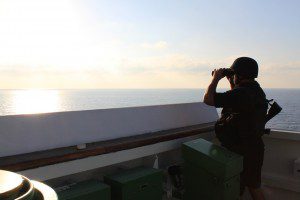 One of the arguments made against arming merchant ships as defense against pirates is the claimed threat that doing so will merely escalate the violence deployed by pirates. I have disputed this argument in the past (See ‘Armed Merchant Ship Crews Will Not Escalate The Pirate Problem‘). Here is another article that takes aim at the escalation of violence theory, nicely pointing out that the military forces in the area are the ones who are escalating the violence.
One of the arguments made against arming merchant ships as defense against pirates is the claimed threat that doing so will merely escalate the violence deployed by pirates. I have disputed this argument in the past (See ‘Armed Merchant Ship Crews Will Not Escalate The Pirate Problem‘). Here is another article that takes aim at the escalation of violence theory, nicely pointing out that the military forces in the area are the ones who are escalating the violence.
ON May 16, 2011 a US military helicopter opened fire on a skiff attacking crude carrier Artemis Glory in the Gulf of Oman, killing four suspected pirates.
Although the US forces were not directly fired upon, the engagement took place under a term called ‘extended unit self-defense’. An American term, it seeks to identify an increased frequency of action or engagement that equates to increased “opportunity” or “crossing of paths” between pirates and coalition forces.
While this demonstrates the Combined Maritime Forces’ resolve in the fight against piracy, it also displays a further example of an escalation of violence, a phrase often used by the detractors of the armed deterrent. There is strong opinion that to counter pirate attacks with the threat and delivery of lethal force puts the masters and crews of vessels under ever more danger of injury or loss of life. More often than not the risk of an ‘escalation of violence’ is used as an argument against the use of private security companies, perhaps unfairly so.
In order to analyse the ‘escalation of violence’ risk, the differences between rules of engagement and rules for the use of force should be considered. Arguably, this is where the difference between state and non-state stakeholders is most acute. ROE is a commonly understood term in the military. It is a set of guidelines to determine when, where and how force should be used. The UK’s Ministry of Defence defines ROE as: “Directives issued by competent military authority which delineate the circumstances and limitations under which UK forces will initiate and/or continue combat engagement with other forces encountered.” However, the UK’s military contribution to EU Navfor is governed by UK domestic and international law as its anti-piracy operations are not defined as ‘armed conflict’, restricting their rules of engagement to self-defence. Contrast this with RUF, which apply to non-state actors, stipulating when a security operative can exercise proportional use of force, also underpinned by ‘self-defence’. Reputable private maritime security companies provide a deterrent with rules for the use of force and not engagement.
Interestingly, between the state-sponsored international naval presence off the Horn of Africa and the privately contracted security personnel, it is the latter who are often criticised for their use of force which needlessly escalates violence. There is no evidence for this and yet there are examples of state actors doing just that, albeit under different ‘rules’, but often taking a difficult situation into something with fatal consequences. One only has to recall the events on board the French yacht, ‘Tanit’, in April 2009, where French Special Forces boarded the hijacked yacht, killing the pirates but also one of the hostages. Similarly there was the killing of four US citizens on board the yacht ‘Sea Quest’ after the pirates suspected they were about to be boarded. In all the subsequent media reports, there was little mention of state actors escalating violence to an unacceptable level. Perhaps state actors are immune from accusations of ‘escalation of violence’, but private actors are not?
Contemporary piracy is widely accepted as a highly organised criminal activity. Shipowners know that the only effective deterrent to this problem is private armed security. Per Gullestrup, chief executive of Clipper Ferries/Ro-Ro said recently: “We took the decision three to four months ago that we could not defend our ships without contracting-in armed guards with light machine guns and who will shoot back.” Even the US acknowledged at the recent US Committee on Foreign Affairs’ Sub-Committee on Terrorism, Non-proliferation and Trade Hearing on “Confronting Global Piracy” (June 15, 2011): “It is notable that no vessel with an armed security team embarked has been successfully hijacked.”
While private security companies are providing a credible deterrent, as non-state actors, they cannot and should not utilise ROE methodology. As is predominantly the case across the maritime security sector, the deterrent operates under clearly defined RUF and tries very hard to detune situations with the minimum use of force. Reputable security companies are only too willing to provide prospective shipping clients with detailed guidelines their teams operate by, from the identification of hostile intent and hostile acts and the appropriate responses deemed necessary to counter the threat. This information is also specified within the recent International Maritime Organization guidelines for the selection and use of private maritime security contractors. The emergence of the Security Association for the Maritime Industry, a trade organisation establishing minimum standards for security companies to operate by, is making it much simpler for shipowners considering armed security to understand the rules for the use of force that PMSC’s should abide by.
Lamentably, the same recent US hearing openly admitted: “We should have no illusions: there is no simple solution to modern-day piracy off the Horn of Africa.” Mr Gullestrup describes the situation more forcefully: “Despair is a good word to describe the way shipowners feel about the whole piracy issue … it is 2011 and we are five years into this and we are still being run around by a bunch of criminals.” While the international community moves toward more asymmetric tactics against pirates, without careful scrutiny and consideration the difference between the rules of engagement and the use of force at sea could be lost in the armed deterrent debate. This could be bewildering for shipowners, charterers and insurers keen to safeguard vessels, content and crew. Perhaps more importantly, it is unhelpful in promoting a clear understanding of state and non-state players’ responsibilities and authority to deliver maritime security, further limiting a coherent solution to contemporary piracy.
Paul Gibbins is the Director of Communications for Protection Vessels International Limited. – Lloyds List (Republished with permission of the author)
The ongoing threat of pirates has resulted in a steady shifting towards greater acceptance of the use of arms onboard ships. This makes sense as it is the vessels that are the high value targets. And as such, they should have the means to defend themselves. So far, there seems to be little in terms of escalation on the part of the pirates. Instead, they continue searching for the less defended vessels.
Photo courtesy of PVI LTD

 Join The Club
Join The Club












